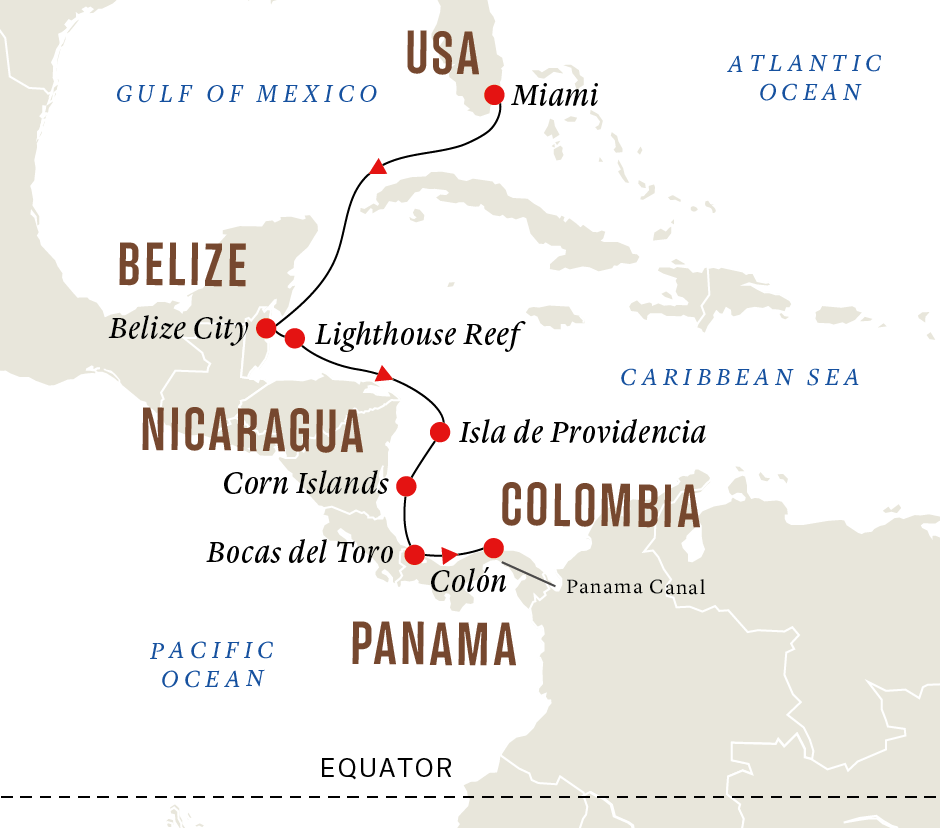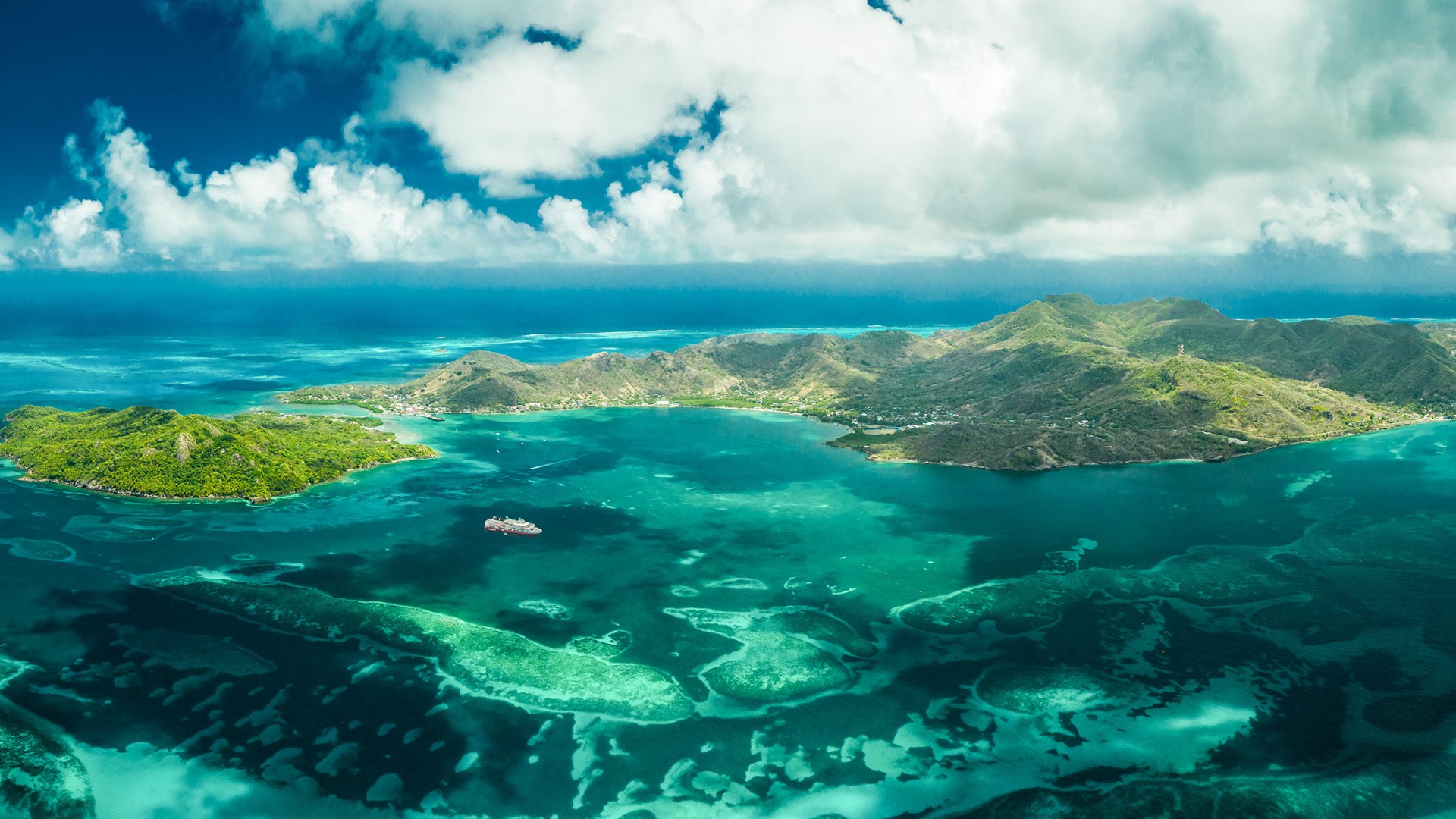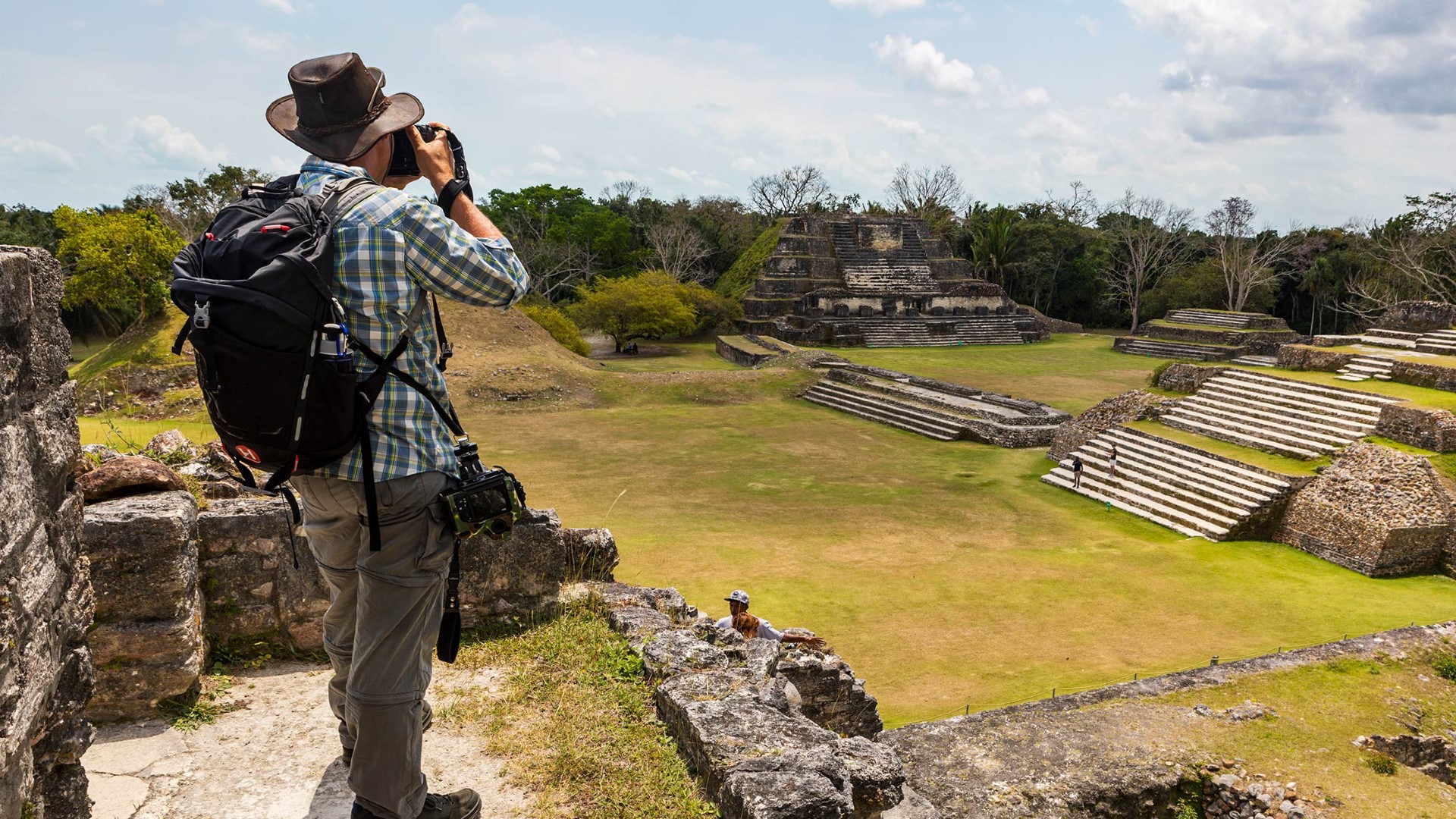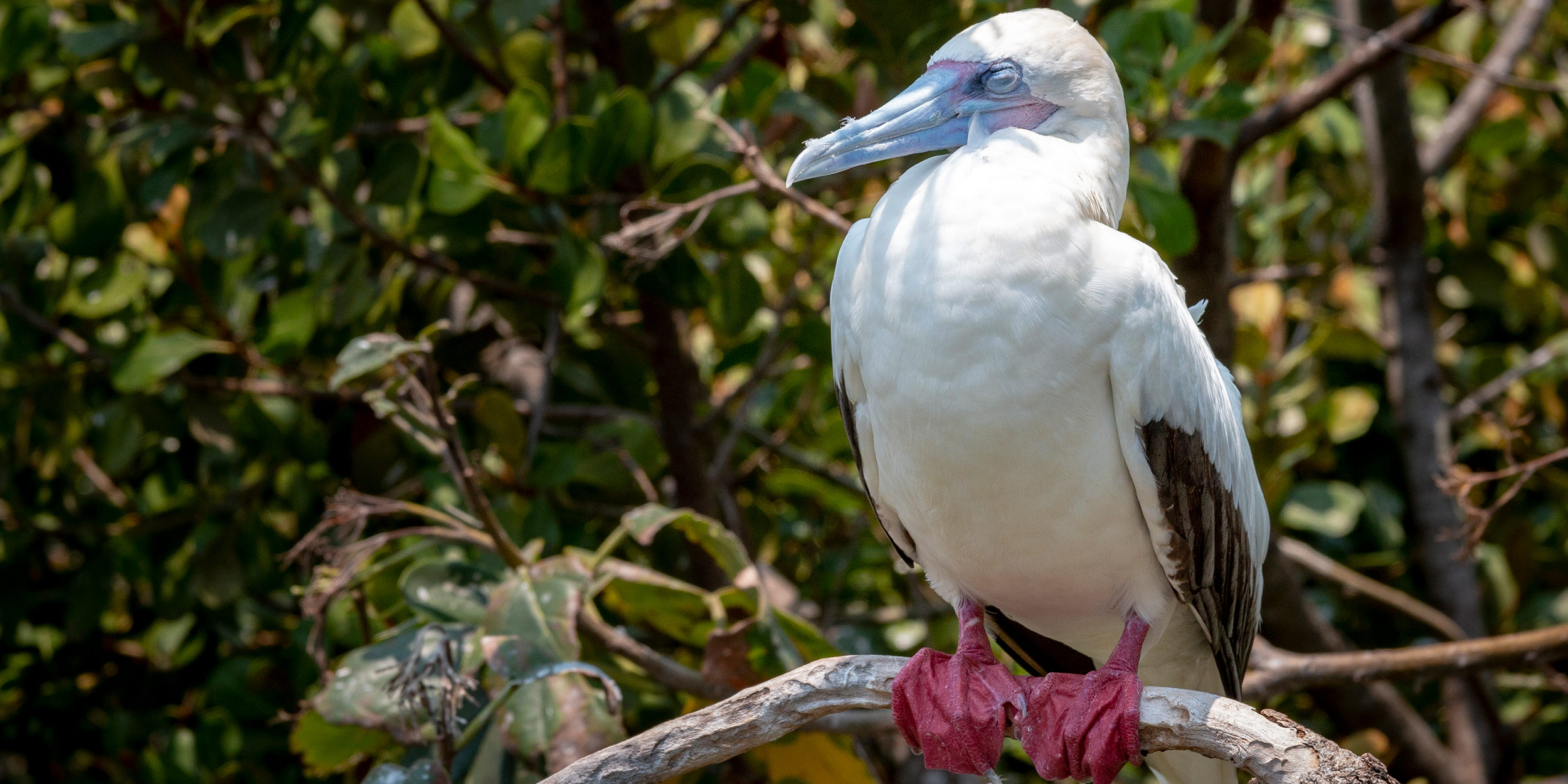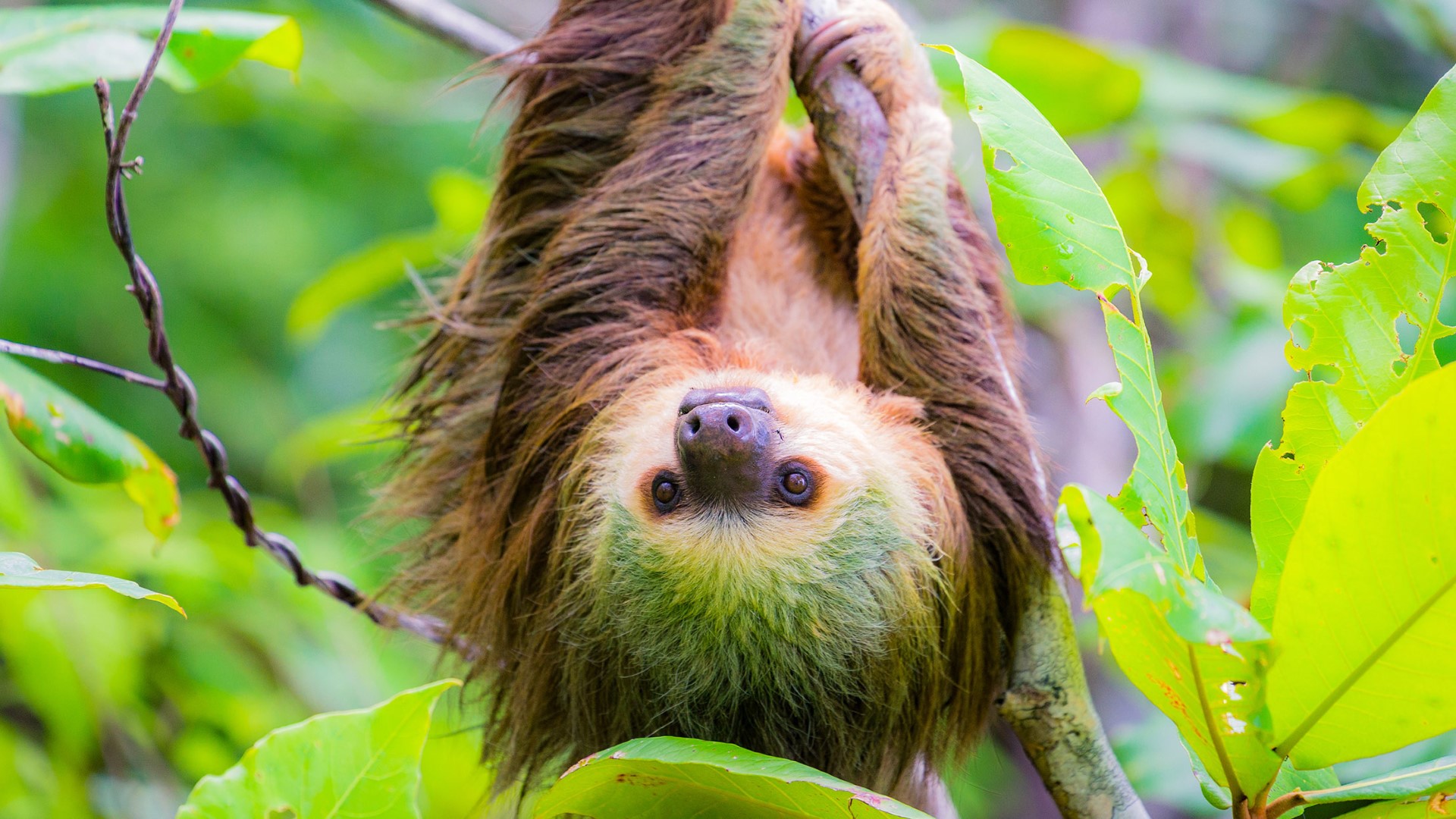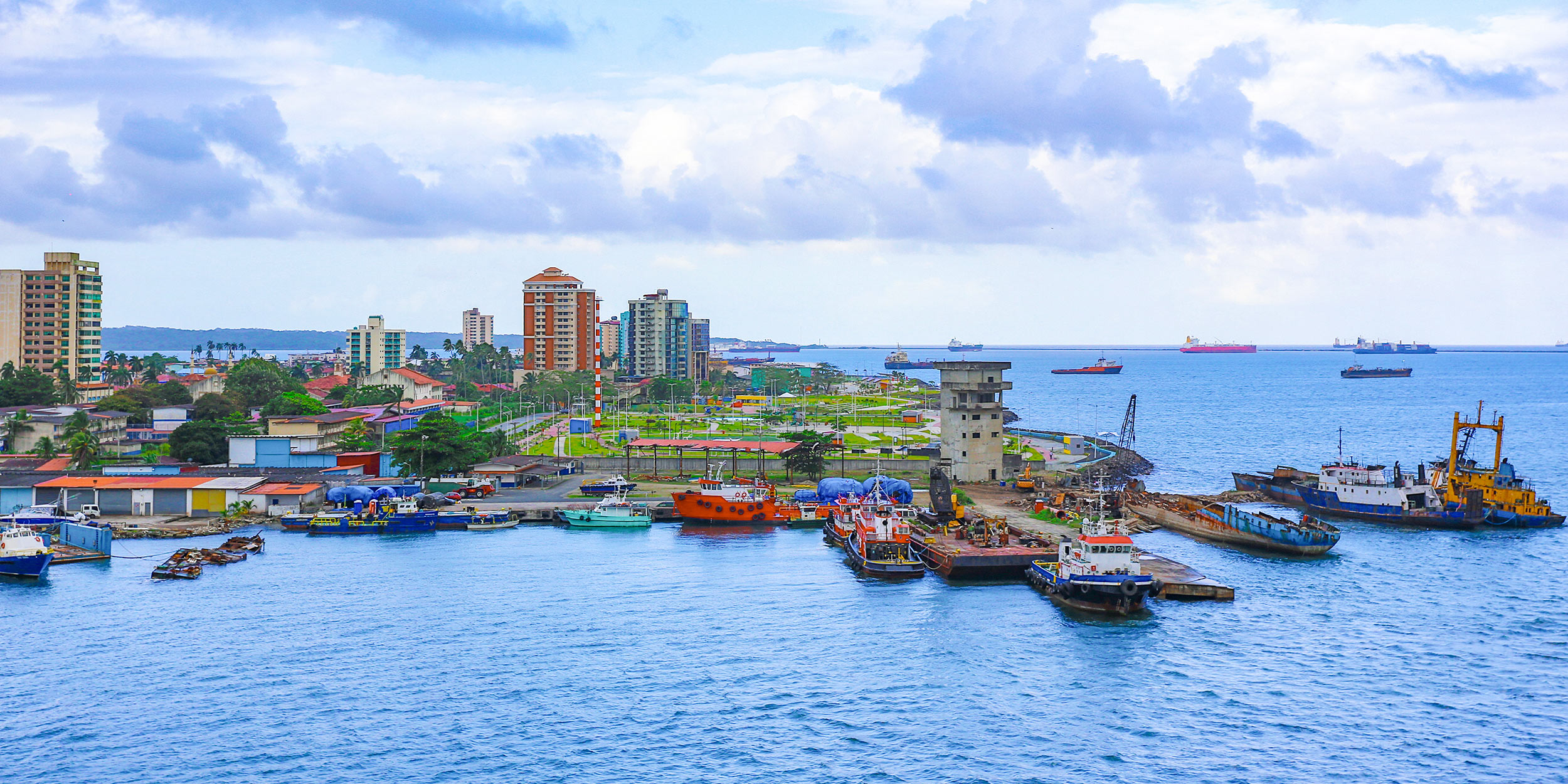Caribbean Vibes & Ocean Exploration
CAD $4,160
10 days / 9 nights
Your cruise begins in the city of neon, Miami. From here, we head south to experience a slice of Mayan heritage before disconnecting from the rest of the world as you encounter island living, vibrant sea life, and mesmerizing coral reefs.
Itinerary
You’ll spend one night in a centrally located hotel in Miami Beach. The sun-soaked city of Miami is the perfect launchpad for your expedition cruise. The reputation of the ‘City of Neon’ as one of the world’s most popular vacation destinations is well earned, and you’ll see why. Year-round sunshine? Check. White-sand beaches? Yes. Clear teal waters? Gorgeous. These are just a few reasons why visitors come in droves.
But there’s a lot more to Miami than cocktails and red carpets. Delve deeper and you’ll find a thriving metropolis with vibrant doses of Latin American, Caribbean, Asian, and European influences.
Searching for trendy clubs and bars? Head to South Beach, day or night. Want a tour of the highest concentration of elegant art deco architecture in the world? You’ll find that in the Art Deco Historic District. A taste of exotic Cuban Culture? Head to Little Havana.
Once you board the MS Roald Amundsen, you’ll pick up your complimentary expedition jacket, settle into your cabin, explore the ship, and attend a mandatory safety drill.
You will also meet our Expedition Team. You will be spending a lot of time with on your voyage. Celebrate the beginning of your adventure at sea with the first of many sumptuous dinners.
We’ll spend our first two days at sea preparing you for the tropical island experiences that await you. First things first, you’ll want to acquaint yourself with your comfortable expedition vessel.
Feel free to indulge yourself with a treatment in our Wellness Center. Take part in an art workshop. Invigorate yourself with a yoga session. Eat in style in one of our three restaurants, and spend time out on deck looking for seabirds and other marine wildlife.
You’ll also use these days at sea to better get to know the Expedition Team. They’ll deliver in-depth lectures on a wide range of subjects relating to your cruise. Lecture topics may include oceanography, Mayan culture, coral reefs, Caribbean Sea creatures, island biogeography, archeology, and stargazing.
You can also pick up tips from the onboard photographer to capture the best images possible.
Welcome to Belize City, the largest city in Belize. This is a hub of Colonial architecture, lively shopping areas, and seaside parks. Among the urban scenery, you’ll find colorful Colonial architecture, a reminder of the city’s past as the country’s former capital. Looking for a one-stop introduction to Belize? Head to Old Belize. The Old Belize train ride is a moving museum through five different exhibitions, showcasing Belize’s history and natural beauty. Or spend time browsing art galleries or the Museum of Belize for some Mayan history.
Our main destination this day lies 30 miles north of the city: the well-preserved Altun Ha ruins. Excavated in 1968, there are two main plazas and thirteen structures. Weather permitting, climb the ancient temples and imagine what the area was like over 2,000 years ago, when Altun Ha was a wealthy trading town. Besides its ancient plazas, Altun Ha is surrounded by a rich array of wildlife. Over 200 species of birds have been sighted here, along with bats, raccoons, tapir, armadillos, and white-tailed deer.
Belize’s famed barrier reef is the country’s masterpiece, considered to be one of the best marine sites in the entire Caribbean. It hosts a thrilling variety of sea life, lush keys, and opportunities to participate in water activities.
We anchor for the day at the uninhabited Half Moon Caye Island, in the Lighthouse Reef, the most remote of the atolls. The island is best known as a sanctuary for the rare red-footed booby, their only nesting site in the region.
Follow local guides along the sandy trails to the bird tower. This will provide you uninterrupted views of nesting boobies and magnificent frigate birds. Large iguanas sometimes like to sunbathe on the paths so you might spot a few as you explore.
Half Moon Caye is also the country’s first marine protected area and a UNESCO World Heritage Site. It’s crystal-clear waters are home to endangered loggerhead, hawksbill, and green turtles. Optional snorkeling excursions are available at the Blue Hole, a massive watery sinkhole in the reef with a kaleidoscopic array of fish.
After two active days, you’ll be grateful to recharge your batteries on the comfortable state-of-the-art vessel. Start the day with some yoga or join the Expedition Team for lectures on topics that can vary from wildlife and geology to the indigenous peoples we may encounter.
This is also the perfect time to see what’s happening in the Science Center. Our access to some of the most remote parts of the world enables us to provide precious data to the scientific community. We invite you to take part in these Citizen Science projects!
For example, the chief scientist on the Expedition Team takes Secchi disk samples of the water as we sail. These samples contain plankton, the basis of the oceanic food chain. Their distribution, abundance, and seasonality are affected by climate change. Studying plankton helps the scientific community keep abreast of overall patterns of the planet. This is just one of the things that sets our expedition cruise apart from traditional cruises.
Feel free to spend time on deck enjoying fresh sea air as you watch for wildlife. After a sumptuous dinner, relax in the elegant Explorer Lounge or do some stargazing in the pristine sky, unobstructed by light pollution.
This remote Columbian island in the Spanish Caribbean was once used as a base by 17th-century Pirate Henry Morgan to plunder passing imperial galleons loaded with gold doubloons. Legend has it that much of his treasure still remains on the island. Believe the legend or not, it’s indisputable that the true treasure here lies in its gorgeous sandy beaches, charming locals, and pristine waters.
Sadly, the island was affected by Hurricane Iona in 2020. Rebuilding works are underway and our visits are vitally important in supporting local businesses and the community as a whole to recover.
There are no public buses, so the humble golf cart is many
peoples means of exploring the island’s beaches and villages. There are a limited number available, but exploring on foot is just as enjoyable.
Hiking to the highest point of the island is not for the faint of heart, but if you do, your reward is breathtaking views of the island and the sea beyond. Frigate birds, iguanas, and electric blue lizards are just some of the local wildlife you might encounter on the way.
The seas around the island are shallow and surrounded by beautiful coral. The diverse coral reefs are the center point of UNESCO’s Seaflower Biosphere Reserve, an oceanic archipelago of rare systems in the Caribbean Sea. Snorkelling here will give you the chance to spot the now-famous clownfish, turtles, and manta rays.
One of the best features of our expedition cruises is taking you to smaller, hard-to-reach destinations that are often missed by the bigger cruise ships. We plan to land on Big Corn Island, roughly 50 miles off the coast of Nicaragua.
The sea here often has a big swell, so the island only receives a few visitors year round. Wind and waves permitting, we will be among the lucky few to discover one of the Caribbean’s best-kept secrets.
You’ll find none of the usual tourist traps here, just a slow island vibe with beautiful beaches and genuinely friendly locals. In fact, don’t be surprised if you’re greeted with local dance and music. You’ll get the feeling that everybody knows everyone in this place and you’ll be welcome wherever you go. The lobster is juicy and the hammocks are abundant.
Getting around the island is easy—there is literally one paved road that goes around the whole island. The beach is the obvious draw, but even a small effort to explore will reward you with charming street art and restaurants. Hike up Mount Pleasant Hill for views of the coves and stunning horseshoe bays.
In keeping with the theme of the expedition, the coral reefs surrounding both Big and Little Corn are pristine–and beautiful. If you haven’t already, this is your chance to immerse yourself in the water. Watch the world go slowly by in a kayak or on top of a stand-up paddle board (SUP).
Bocas del Toro is a stunning archipelago made up of nine main islands and hundreds of smaller ones. Clear blue waters? Check. Densely forested islands? Check. Uninhabited islets? Check.
This is what people imagine when they dream of paradise. Now a UNESCO World Heritage Site, this National Marine Park is one of the most biologically diverse places on Earth, and its many islands have an exotic mix of wildlife spread across its many islands.
Take a local water taxi to one of the surrounding islands and go on a guided walk. One place we might visit is Red Frog Beach, where you can try and spot those aptly named frogs.
Or visit Solarte Island, which has a number of hiking trails. The tropical rainforest here is home to industrious leaf-cutter ants and hums with the calls of exquisite birdlife. If we’re lucky, we might spot red frogs and three-toed sloths.
There are also optional excursions to visit a sustainable cacao farm or snorkel in Zapatilla Cay, where the hit TV show Survivor was filmed.
Your wonderful tropical voyage concludes at the Caribbean entrance to the Panama Canal. This bustling port town is a popular stop for cruises going to the Caribbean and has a diverse population for such a small size.
If you want to really explore the city, you can join a Post-Program where you’ll spend three extra nights in a beautiful jungle lodge next to the Chagres River. During your stay, you’ll visit a rainforest centre and a farm working with reforestation, explore the jungle on a night boat safari, and enjoy views of the area by cable car.
Another Post-Program travels to Casco Viejo, arguably the most charismatic neighborhood in Panama City. Stroll the rustic cobblestone streets and plazas; admire the architecture of Colonial churches, mansions, and the Metropolitan Cathedral; and try local specialties like coffee and cocoa.
You can even book another expedition cruise from here that takes you through the ingenious man-made locks of the Panama Canal and through to the Pacific Ocean on the other side. Then go on to explore the many sights and coastal cities of South America.
Whatever’s next for you, we wish you a safe onward journey and look forward to seeing you on your next adventure!
Dates & Prices
| Start/End | Nights | Sailing Schedule | Starting From |
|---|---|---|---|
| Miami, Florida / Colón, Panama | 9 | Sept 29 - Oct 8, 2022 | $4,160 |
*Price per person based on double occupancy. Due to the dynamic nature of availability and pricing, please click here to contact us directly for sailing schedule and full pricing.
Featured Inclusions

Expedition cruise in a cabin of your choice

Breakfast, lunch, and dinner including beverages (house beer and wine, sodas, and mineral water) in restaurant Aune

Experts from the Expedition Team present detailed lectures on a variety of topics

Escorted landings with small boats (RIBs)

Complimentary wind- and water-resistant expedition jacket
Ship Information
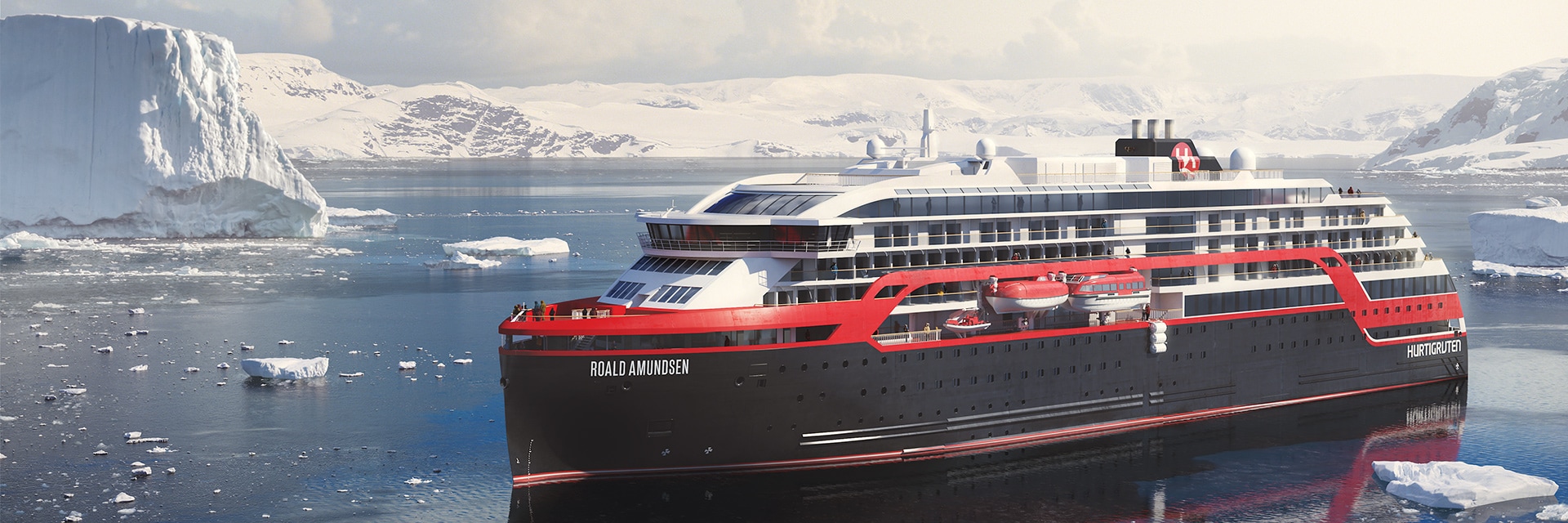
MS Roald Amundsen
MS Roald Amundsen is the first of two hybrid ships Hurtigruten will add to its fleet over the next few years, cutting emissions by sailing with electrical propulsion. Hybrid technology, combined with the advanced construction of the hull and effective use of electricity on board, will reduce fuel consumption and CO2-emissions on the ships by 20%. The building of these two ships represents the largest single investment in the history of Hurtigruten.

